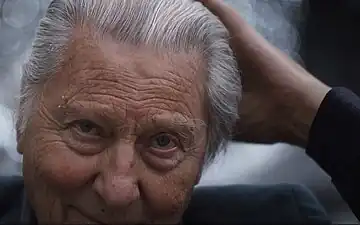Sylvain Saudan
Sylvain Saudan (born 23 September 1936 in Lausanne, Switzerland) is an extreme skier, dubbed "skier of the impossible." He is noted for skiing down large and steep mountains, including those in the Himalayas, North America, Asia, Africa and Europe. In 1982, he entered the Guinness Book of World Records for conquering the highest most steepest slope ever skied.
Sylvain Saudan | |
|---|---|
 Saudan in 2021 (aged 85) | |
| Born | September 23, 1936 |
| Nationality | |
| Occupation(s) | Alpine Skier and Mountaineer |
| Known for | Extreme skiing |
| Spouse | Marie-José Valençot |
Early life and career
Saudan was raised near the village of Verbier in Valais, Switzerland, where skiing to school during the winter was the norm.[1] In the early 1960's, Saudan qualified as a skiing instructor and high mountain guide.[1] By 1967, he was considered by the skiing fraternity, to be the master of extreme skiing, earning him the name "skier of the impossible".[2]
In mountains people are usually known for first ascent of high and difficult peaks but he is famous for accumulating 23 first descents,[2] which includes the most difficult 18 descents known.[See (see French Wikipedia)].
Saudan's crowning achievement came in 1982 when, at age 46, he skied down Pakistan's 26,470-foot (8,070 m)-high Gasherbrum I, or Hidden Peak, in the Himalayas.[2] It was, and possibly still is, the longest 50-degree ski descent ever accomplished and likely the first full descent of an '8,000 meter' mountain. The feat earned him a place in the Guinness Book of World Records for the highest and steepest slope ever skied.[2] In 1972, he ran Himalaya Heliski, based in Srinagar offering heliskiing trips in Kashmir region.[1] In 2007, aged 71, he survived a helicopter crash in Kashmir.
Technique
In order to safely ski these mountains he developed a new technique to "jump turn" on very steep inclines.[3] Normal jump turns would have accelerated the skier and thrown him too far down the mountain so, using long ski poles, Saudan turned by planting a ski pole downhill and, keeping his weight on both skis and leaning back on his heels, he lifted the ski tips up and swivelled them in an arc into the turn.[3] These turns, rhythmically swivelling the skis in arcs left and right, he christened the windscreen wiper turns.[4][3] His extreme exploits involved considerable preparations, studying the mountain, the snow, and the terrain over an extended period of time.
Later life
He was an accomplished guide for heliskiing, one of the first European guides, along with Hans Gmoser, to exploit the Bugaboos in British Columbia in the 1970s, with waist deep powder snow (often 150,000 vertical feet per week or more). He later developed his own line of skis suited for powder skiing. These were relatively short and wide metal skis, designed to be quick turning in powder snow, as well as to be easily loaded outside the helicopters.
Saudan became a motivational speaker in later life for corporate executives, using his films to demonstrate the leap in courage it takes to conquer new peaks and new challenges.
Timeline of achievements
- 1967 - He performed the first descent of the direct 45 degree line of the Couloir Sans Nom on the face of the Rothorn.[1]
- 1967 - He skied the north face of the Piz Corvatsch near St. Moritz, around 1000 meters of vertical at over 45°.[1]
- 1967 - His descent on skis down the 55-degree Couloir Spencer on the Aiguille de Blaitière, Mont Blanc massif.[4]
- 1967 - He skied the Couloir Whymper on the Aiguille Verte.[1]
- 1968 - He climbed then skied back down Couloir Gervasutti on the Mont-Blanc du Tacul fell.[1]
- 1968 - He skied the couloir Marienelli of the Monte Rosa, Pennine Alps.[1]
- 1969 - He skied the North West face of the Aiguille de Bionnassay of the Mont Blanc massif.[1]
- 1970 - He skied the west face of the Eiger, Bernese Alps.[3]
- 1970 - He skied the south face of the Grandes Jorasses.[1]
- 1970 - He skied the couloir of the Tournette on the south west side of Mont-Blanc.[1]
- 1971 - He descended the 50-degree (55 in places), slope of the couloir on the Northeast side of 3419 meter Mount Hood, Oregon, U.S.[1]
- 1972 - He climbed, then at -35 degrees C, ascended the south-west face of Denali (Mount McKinley), Alaska Range, highest peek in North America.[4]
- 1972 - He climbed then skied back down Kilimanjaro, the highest mountain in Africa.
- 1976 - He climbed then skied back down 7,135m Nun peak in the Himalayas.[4]
- 1976 - He climbed then skied back down a number of other peaks in Nepal and the Karakoram.
- 1982 - He skied down Pakistan's 26,470-foot (8,070 m)-high Gasherbrum I, or Hidden Peak, in the Himalayas.[2][1]
- 1986 - On his 50th birthday, he skied down from the 3,776m summit of Mount Fuji, without snow, on scree.[4]
Quotes
- I don't live for the mountain. I couldn't live without her. I live with her. (in Dreyfus, p. 31).
- When you ski down a corridor, you're really edging death with each move that is not perfectly controlled. There's really only one way out: don't fall down. (in Dreyfus, p. 270).
References
- Paul Dreyfus (1970). "Sylvain Saudan: Skieur de L'Impossible". Book. Arthaud. Archived from the original on July 8, 2011.
- Karin Larsen (November 12, 2017). "Sylvain Saudan, 'godfather of extreme skiing,' lends his name (again) to Blackcomb Mountain". cbc.ca.
- "Skiing the Steeps (Page 2 of 4)". The New York Times. January 25, 1981. Archived from the original on May 25, 2015.
- Graham Bell (December 20, 2016). "Meet Sylvain Saudan, skier of the impossible". telegraph.co.uk. Archived from the original on December 21, 2016.